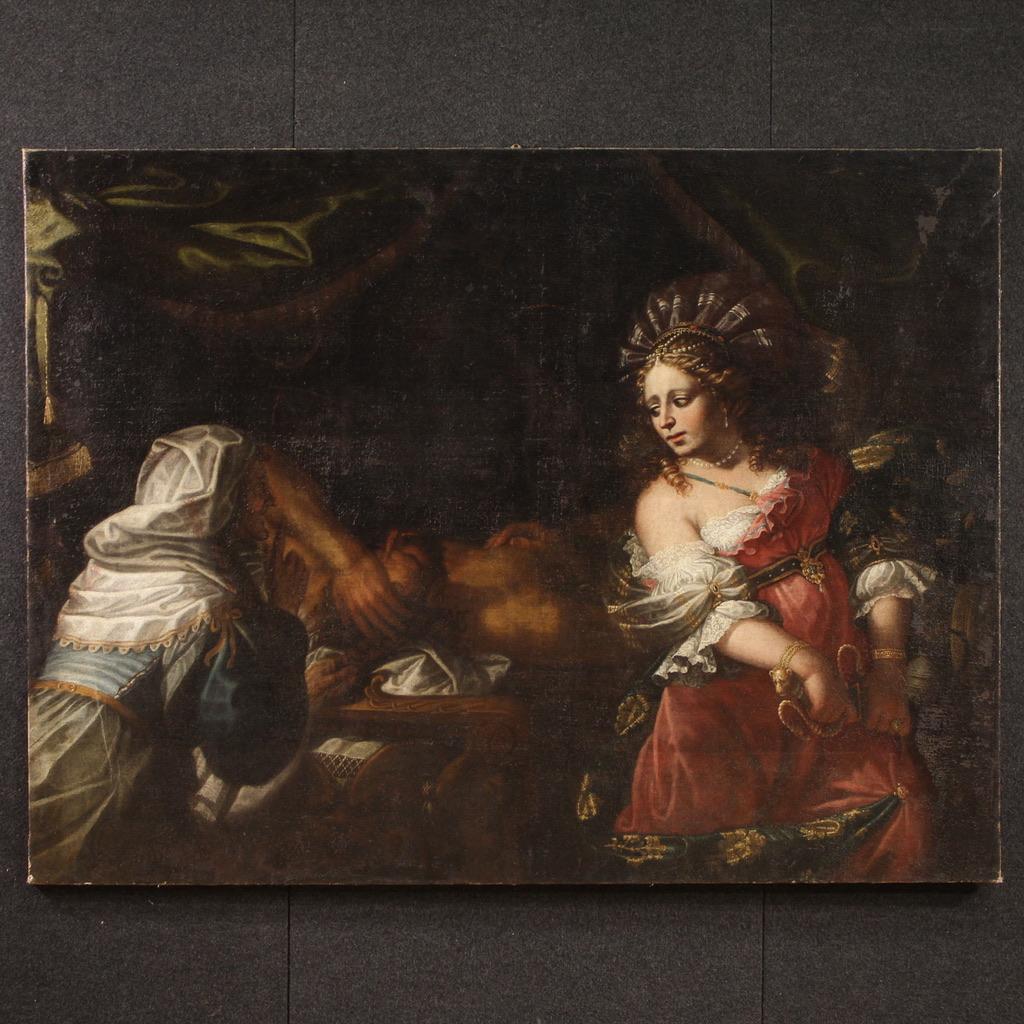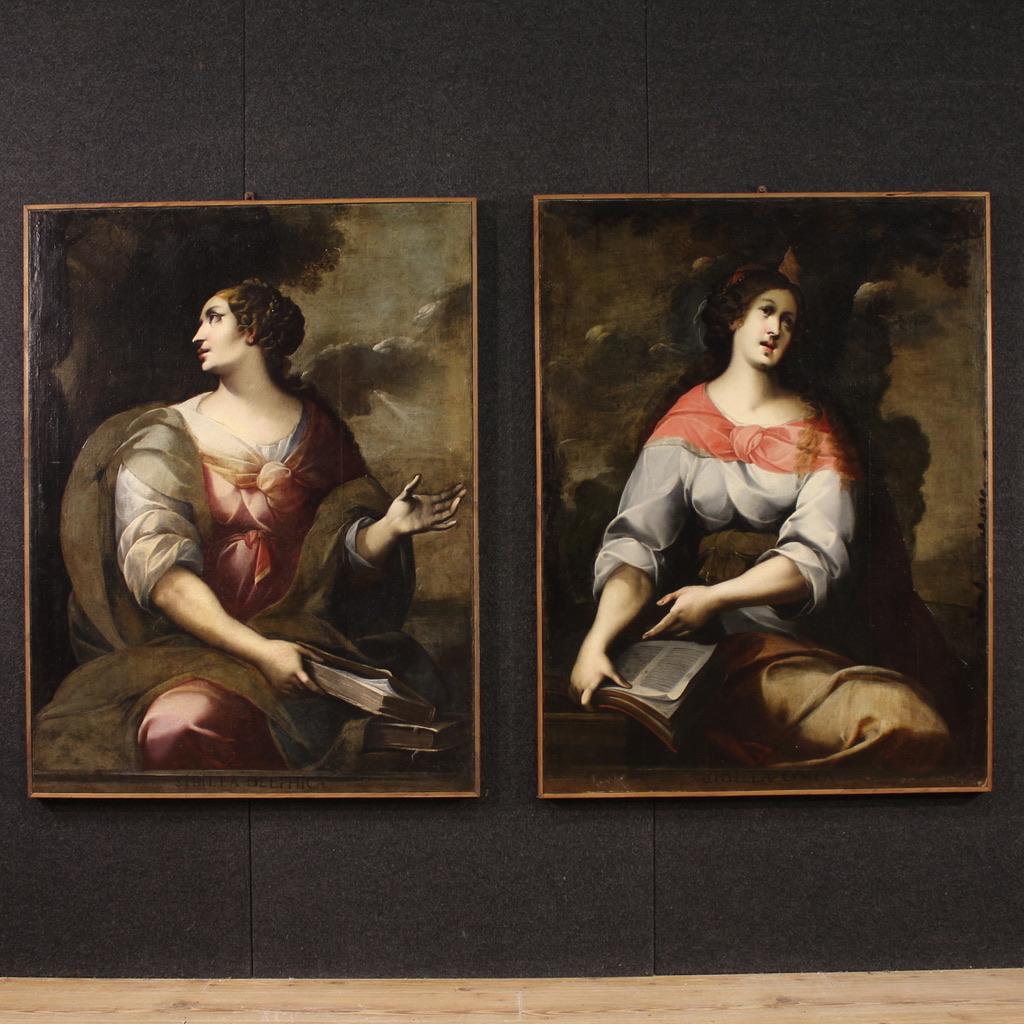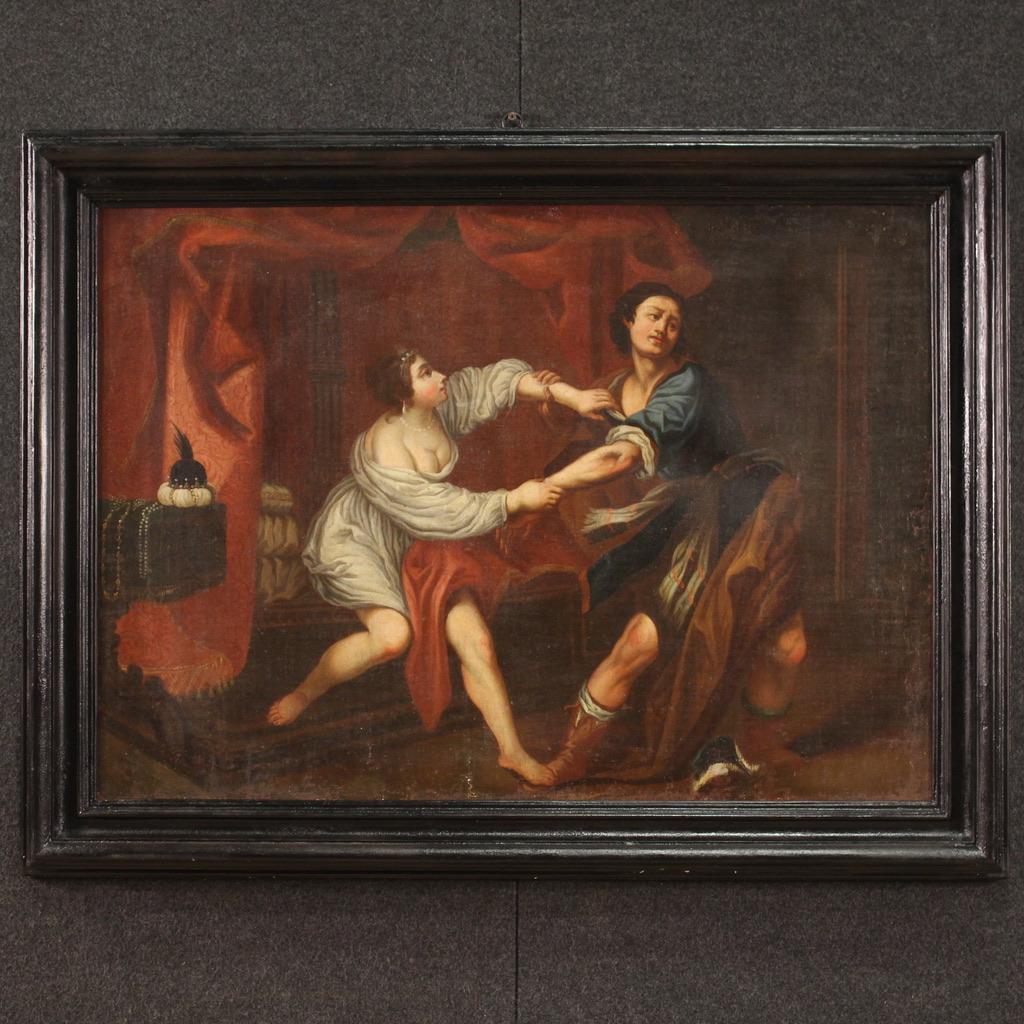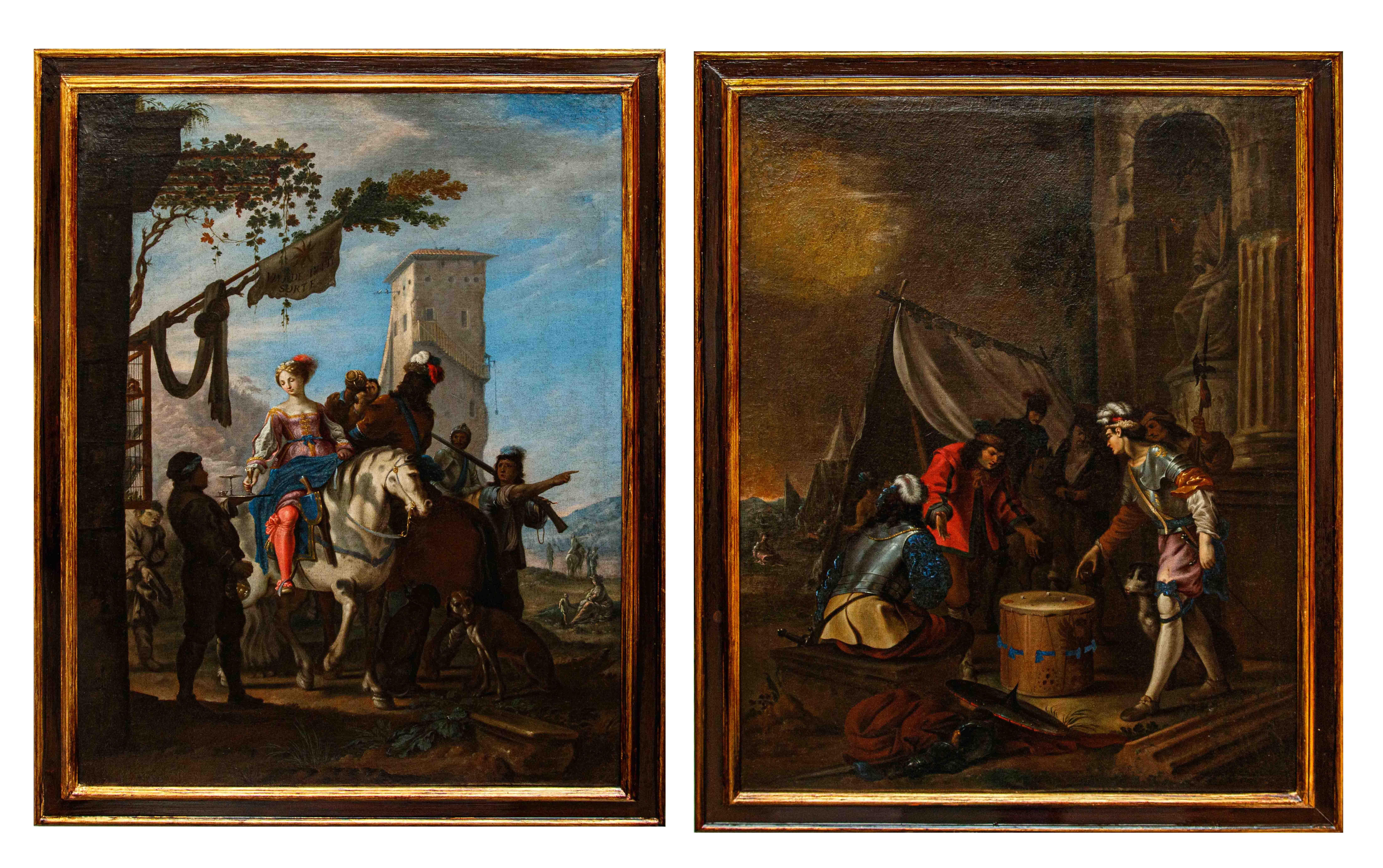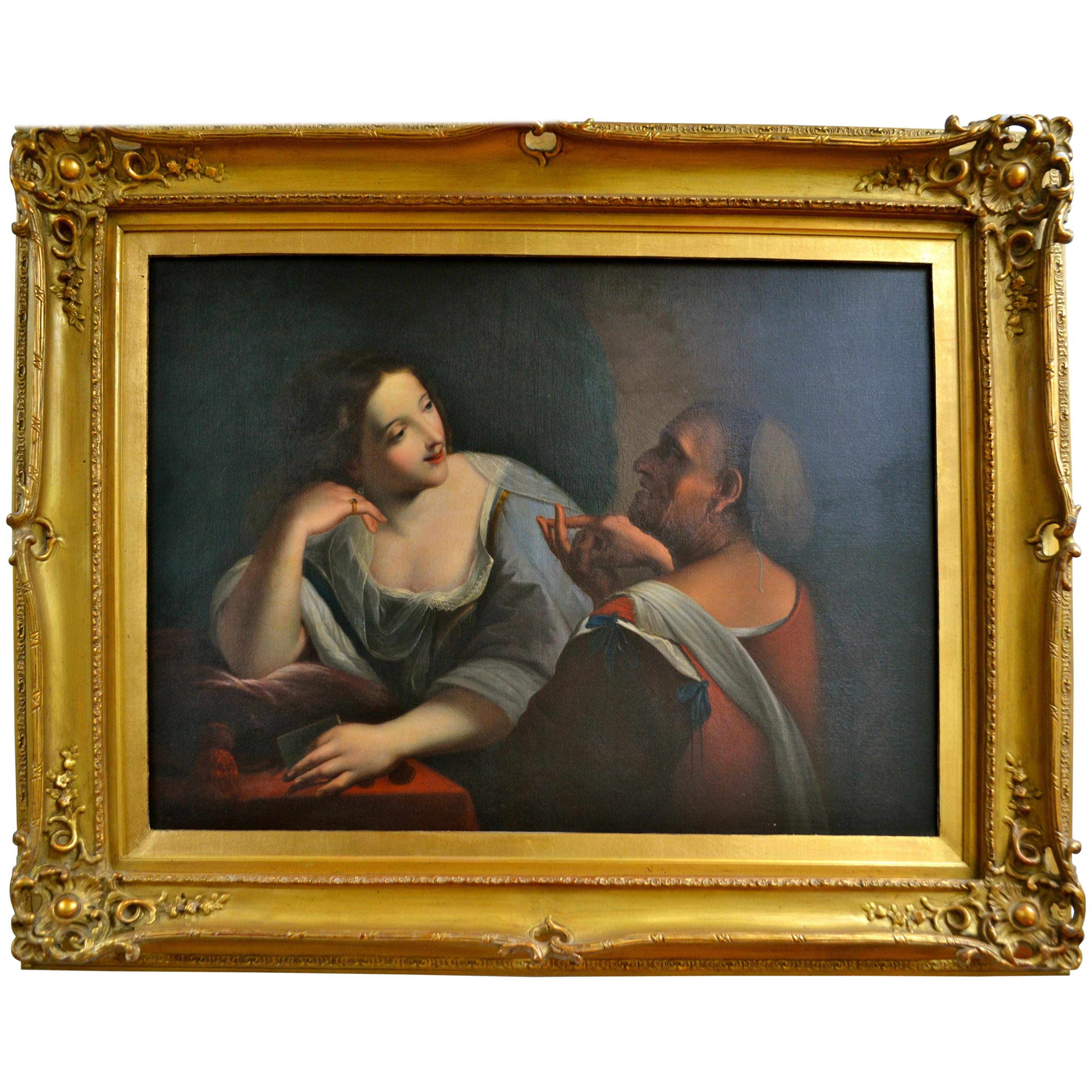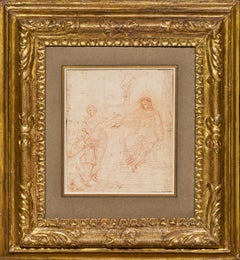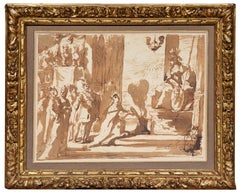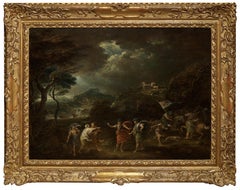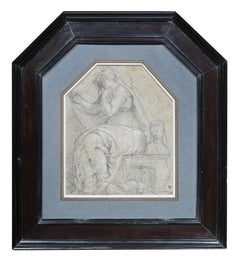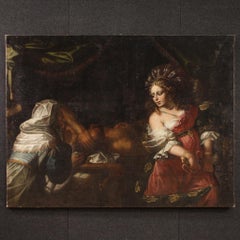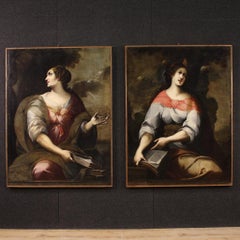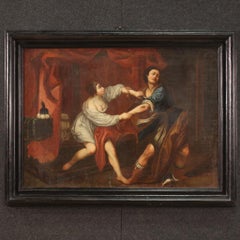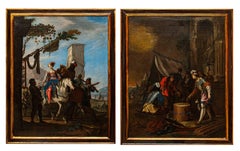Items Similar to Judith and Salome, a pair of oil paintings on canvas by Francesco Conti
Want more images or videos?
Request additional images or videos from the seller
1 of 19
Francesco ContiJudith and Salome, a pair of oil paintings on canvas by Francesco Conticirca 1710-1720
circa 1710-1720
$75,890.83
£56,419.52
€64,000
CA$105,171.03
A$117,245.49
CHF 61,148.35
MX$1,417,769.68
NOK 768,664.65
SEK 727,310.37
DKK 487,248.56
About the Item
This widely referenced pair of paintings is one of Francesco Conti’s most successful productions. Francesco Conti is one of the finest painters of 18th-century Florence. In the shimmering colors typical of his best work, he represents two opposite characters from the Bible: the virtuous Judith, whose courage saves her people by cutting off the head of the invader Holofernes, and the depraved Salome, who under the influence of her mother becomes responsible for the beheading of the prophet John the Baptist.
The artist's talent lies in his ability to treat these two macabre subjects with a light touch, presenting us with two attractive women who seem to twirl with glee amidst the severed heads...
1. Francesco Conti, the “Florentine Tiepolo”
Francesco Conti is a major painter of the Florentine school of the 18th century; he can even probably be considered, along with Giovanni Domenico Ferretti (1692-1768), as one of the two main painters of the second quarter of the Florentine 18th century.
Born in Florence in 1682, Francesco Conti began his apprenticeship in the workshop of Simone Pignoni (1611 - 1698), a disciple of Francesco Furini; he was also influenced by the Venetian Sebastiano Ricci. A protégé of Marquis Riccardi, he accompanied him to Rome between 1699 and 1705, where he frequented Carlo Maratta's studio. He settled permanently in Florence in 1705.
Painted exclusively on canvas, the majority of his work consists of religious subjects, altarpieces or private devotional works. It is likely that Conti himself was a devout churchgoer, as evidenced by his affiliation, in the third decade of the eighteenth century, to the Society of the Disciples of Saint-John-the-Baptist, and his entry, at the end of his life, into the fraternity of the Venerable Society of the Holy Trinity.
In Florence, Conti worked for the Grand Duchy's major patrons, including the last Medici - in particular Giangastone and Annamaria Luisa, Electress Palatine - and confirmed his role as a reference painter under the Lorraine Regency, as master of the Public Drawing School, which was closely linked to the institute responsible for the manufacture of semi-precious stone mosaics, then located in the Uffizi complex.
Matteo Marangoni, an art critic of the early 20th century, praised his "brushwork full of elegance and true spirit of the 18th century", pointing out that Conti was "probably one of the best colorists" of the Florentine school of his time. These two characteristics led the art historian Paolo dal Poggetto to nickname him the "Florentine Tiepolo".
2. Judith and Salome, two biblical characters opposing each other
These two paintings form a pair presenting two biblical episodes, which have in common the depiction of a "heroine" carrying the severed head of a man.
While the Salome episode might at first appear to be an echo of the Old Testament story of Judith, each character is the exact opposite of the other. Judith, whose story is told in the Book of Judith, is a beautiful young widow from Bethulia who, accompanied by her maid, went into the camp of the invading Assyrians and won the confidence of Holofernes, the general commanding the enemy army. Invited to a great feast on the fourth evening, she took advantage of Holofernes' drunkenness to cut off his head. “She went up to the bedpost near Holofernes’ head, and took down his sword that hung there. She came close to his bed, took hold of the hair of his head, and said, “Give me strength today, O Lord God of Israel!” Then she struck his neck twice with all her might, and cut off his head. Next she rolled his body off the bed and pulled down the canopy from the posts. Soon afterward she went out and gave Holofernes’ head to her maid, who placed it in her food bag. Then the two of them went out together, as they were accustomed to do for prayer. They passed through the camp, circled around the valley, and went up the mountain to Bethulia, and came to its gates. ” Judith is therefore a model of a strong, deeply religious woman whose courageous action liberates her people and leads them to victory over the invaders.
Salome's character is the exact opposite of Judith's. She is the daughter of Herodias, who left her first husband to marry his brother Herod Antipas. The story of the fateful banquet is recounted in the Gospels according to St. Mark and St. Matthew: " Now Herod had arrested John and bound him and put him in prison because of Herodias, his brother Philip’s wife, for John had been saying to him: “It is not lawful for you to have her.” Herod wanted to kill John, but he was afraid of the people, because they considered John a prophet. On Herod’s birthday the daughter of Herodias danced for the guests and pleased Herod so much that he promised with an oath to give her whatever she asked. Prompted by her mother, she said, “Give me here on a platter the head of John the Baptist.” The king was distressed, but because of his oaths and his dinner guests, he ordered that her request be granted and had John beheaded in the prison. His head was brought in on a platter and given to the girl, who carried it to her mother." Salome is just a child living in a depraved court; she obtains the beheading of a man driven by her mother, to satisfy her whim.
3. Description of the artworks
Judith is depicted in mid-body, her face festooned and her body adorned in her finest finery. The shimmering colors evoke a luminous triumph. With her right hand, she leans on the sword with which she has just severed Holofernes' head, and with her left hand, she brandishes his head, holding it by the hair. Her maid, crouching on the lower right, opens her food bag to collect the severed head.
The angular folds of the maid's clothing are characteristic of Francesco Conti's early artworks, such as his Ascension of the Virgin and Christ in the Garden. They suggest that these paintings were probably produced in the second decade of the eighteenth century.
Salome is also depicted as a woman rather than a young girl. As she advances to bring the dish containing the prophet's head to her mother, she turns to face the guard who has decapitated St. John the Baptist, as suggested by the sword held in his firm hand. The swirl of red cloth surrounding her, which could have an evil connotation, accompanies her moving body. The composition, featuring a cellar lit vertically by an oculus, could be inspired by Titian's Ecce Homo (last photo in the gallery).
The triangle formed by the three heads (Salome's head, which seems to turn towards the guard, and her arm, which guides our gaze from the guard to the head of Saint John the Baptist, whose eyes are closed, but who nevertheless seems to be staring at Salome) is particularly successful and masterly painted.
The presence of feathers in the hairstyles of these two women is also a particularly charming detail: marks of light-hearted coquetry, these feathers contrast with the macabre character of the two episodes depicted and are one of the most representative details of the neo-Mannerist treatment offered here.
These two paintings have been identified as two important works of Francesco Conti since the work of Sonia Meloni Trkulja, which led to renewed interest in Conti's work in the 1980s, as evidenced by the large number of publications in which they appear.
The quality of these two paintings, their singularity in the artist's oeuvre and the limited representation of this important Florentine artist in the Uffizi Gallery's collections (which only include his self-portrait and two artworks in darker colors, a Crucifixion and a Way of Calvary) had led the Gallery to consider their acquisition when the export license for these two works was issued. In the end, this acquisition did not materialize, which means that we can now present them for the first-time outside Italy.
4. Framing
We have chosen a pair of 18th-century Italian frames from the Marche region to frame this pair of paintings.
Literature :
S. Meloni Trkulja - Conti, Francesco in Dizionario Biografica degli Italiani, XXVIII (1983), Roma page 402
S. Meloni Trkulja - Francesco Conti illustrato, Arte Cristiana, 707 (1985) pages 85-86
S. Meloni Trkulja - Conti, Francesco in LA PITTURA (1990), II, page 678
Concept 1995 - Concept of a collection 1650-1994, Donatella Mei, Rivka Rinn - Montespertoli (FI) - pages 6, 30, 32
F. Berti - Francesco Conti pittore fiorentino (tesi di Laurea, Università degli Studi di Firenze 1996-1997) page 84
S. Bellesi - Catalogo dei pittori fiorentini del '600 e '700 - (2009) Firenze I page 113
F. Berti - Francesco Conti - (2010) Edifir Edizioni Firenze pages 134- 135
- Creator:Francesco Conti (1682 - 1760, Italian)
- Creation Year:circa 1710-1720
- Dimensions:Height: 26.88 in (68.28 cm)Width: 22.5 in (57.15 cm)
- Medium:
- Movement & Style:
- Period:1710-1719
- Condition:Dimensions: 26 7/8’’ x 22 ½’’ (68.2 x 57.2 cm) - Framed: 32 7/8’’ x 28 3/8’’ (83.5 x 72 cm) Provenance: Guidi collection, Florence Framing: carved and gilded wooden frames with floral scrolls - Italy, Marche region - 18th century.
- Gallery Location:PARIS, FR
- Reference Number:1stDibs: LU1568214022052
About the Seller
5.0
Vetted Professional Seller
Every seller passes strict standards for authenticity and reliability
Established in 2020
1stDibs seller since 2021
10 sales on 1stDibs
Typical response time: 3 hours
- ShippingRetrieving quote...Shipping from: PARIS, France
- Return Policy
Authenticity Guarantee
In the unlikely event there’s an issue with an item’s authenticity, contact us within 1 year for a full refund. DetailsMoney-Back Guarantee
If your item is not as described, is damaged in transit, or does not arrive, contact us within 7 days for a full refund. Details24-Hour Cancellation
You have a 24-hour grace period in which to reconsider your purchase, with no questions asked.Vetted Professional Sellers
Our world-class sellers must adhere to strict standards for service and quality, maintaining the integrity of our listings.Price-Match Guarantee
If you find that a seller listed the same item for a lower price elsewhere, we’ll match it.Trusted Global Delivery
Our best-in-class carrier network provides specialized shipping options worldwide, including custom delivery.More From This Seller
View AllStudies for the Judgment of Solomon, a double-sided drawing by Simone Cantarini
Located in PARIS, FR
In this double-sided red chalk study, Simone Cantarini offers us a double reflection on the theme of the Judgment of Solomon. This sheet reveals his precise style and his sense of de...
Category
1640s Old Masters Figurative Drawings and Watercolors
Materials
Chalk, Laid Paper
Allegory of the Treaty of Angoulême, a drawing attributed to Donato Mascagni
Located in PARIS, FR
We would like to thank Mrs. Ursula Verena Fischer Pace for suggesting the attribution to Donato Arsenio Mascagni.
We were immediately seduced by the rich tonalities of this allegory...
Category
1620s Old Masters Figurative Drawings and Watercolors
Materials
Ink
Macbeth and the Three Witches a Painting on Panel by Francesco Zuccarelli
By Francesco Zuccarelli
Located in PARIS, FR
This painting, created during Zuccarelli's stay in England, represents the decisive moment when Macbeth, together with Banquo, meets the three witches who announce that he will be Ki...
Category
1760s Old Masters Landscape Paintings
Materials
Oil, Wood Panel
Allegory of Chastity, a drawing attributed to G. Porta with great provenance
Located in PARIS, FR
This magnificent drawing from the Venetian Renaissance intrigues us in many ways. It depicts an allegorical composition whose meaning partly escapes us: a veiled figure seated on a stone bench (which we have identified as Chastity), seems to be turning away from a woman's bust beside her, below which are two rabbits, a traditional allegory of fertility, but also sometimes of lust.
This drawing, executed on blue paper, undoubtedly belongs to the Venetian Renaissance. The inscriptions on the back of the old mounting board indicate the various attributions considered by its last owner, the British painter and art historian Sir Lawrence Gowing. We have retained the attribution to Giuseppe Porta proposed by art historian John Arthur Gere as the most relevant.
We were incredibly fortunate to find a hexagonal frame of a very similar format for this drawing, the upper corners of which were formerly cut (irregularly). This 17th-century Dutch frame comes from an aristocratic collection in Lombardy, and creates a kind of fascinating chase around this Venetian drawing...
Category
16th Century Figurative Drawings and Watercolors
Materials
Chalk
Study in the Antique Style, a neoclassical drawing by Augustin Pajou
Located in PARIS, FR
In this lively and fresh drawing, probably taken from one of the artist's notebooks, Pajou presents us with a composition freely inspired by antiquity, as a souvenir of a visit to th...
Category
1750s Old Masters Figurative Drawings and Watercolors
Materials
Ink
Frieze of antique figures, a drawing by the sculptor Antoine-Denis Chaudet
Located in PARIS, FR
Faithful to the neo-classical taste, sculptor Antoine-Denis Chaudet presents us with a frieze of antique figures executed in gray wash over pencil strokes, which is likely inspired b...
Category
Early 1800s Old Masters Figurative Drawings and Watercolors
Materials
Paper, Pencil, Ink
You May Also Like
18th Century Oil on Canvas Biblical Italian Painting Judith and Holofernes
Located in Vicoforte, IT
Wonderful Italian painting from the first half of the 18th century. Oil on canvas artwork depicting a fascinating biblical story, the beheading of the Babylonian leader Holofernes by...
Category
1720s Figurative Paintings
Materials
Canvas, Oil
Pair of 17th Century Oil on Canvas Italian Antique Paintings Sibyls, 1670s
Located in Vicoforte, IT
Rare pair of Italian paintings from the second half of the 17th century. Oil on canvas artworks depicting two splendid female figures recognizable thanks to the inscriptions at the b...
Category
1670s Figurative Paintings
Materials
Canvas, Oil
$94,863
Free Shipping
18th Century Oil on Canvas Italian Painting Joseph and and Potiphar's Wife
Located in Vicoforte, IT
Antique Italian painting from 18th century. Oil artwork on canvas depicting biblical subject Joseph and and Potiphar's Wife of good pictorial hand. Beautiful measure and pleasant fur...
Category
1750s Figurative Paintings
Materials
Canvas, Oil
Pair of genre scenes attributed to Johann Heinrich Schönfeld
By Johann Heinrich Schönfeld
Located in Milan, IT
Johann Heinrich Schönfeld (Biberach an der Riß, March 23, 1609 - Augsburg, 1684) (attr.)
Gentlewoman on horseback at a tavern and Dice players
(2) Oil on canvas, 98 x 74.5 cm
Joha...
Category
17th Century Figurative Paintings
Materials
Canvas, Oil
Roman Charity (Cimon and Pero)
Located in Paris, Île-de-France
Michel CORNEILLE the Younger (Paris, 1642 – 1708)
Roman Charity (Cimon and Pero)
Black chalk with white highlights on beige paper
Height: 28 cm – Width: 20 cm
Unsigned
France, cir...
Category
Late 17th Century Old Masters Figurative Drawings and Watercolors
Materials
Paper, Charcoal, Chalk
Italian Baroque Style Painting of Beauty and Old Age attributed to R. Manchetti
Located in Vancouver, British Columbia
An old master style 18th century allegorical painting representing youth and old age, and/or beauty and wisdom, depicted by a beautiful young ...
Category
Antique Mid-18th Century Italian Baroque Paintings
Materials
Canvas
More Ways To Browse
Mother And Daughter Painting
Man And Woman Oil Painting
Oil Paintings Of Mother And Daughter
Old Masters Religious Paintings
Folding Photo Frame
Italian Oil Painting Old Man
Antique Oil Paintings Dancers
Crucifixion Paintings
Old Medici
Old Master Mother Child
Oil Painting 3 Girls
Old Antique Bed
Old Antique Beds
Virgin And Child Painting
Pair Of Vertical Paintings
Regency Portrait Of
John The Baptist Painting
Regency Oil Painting
